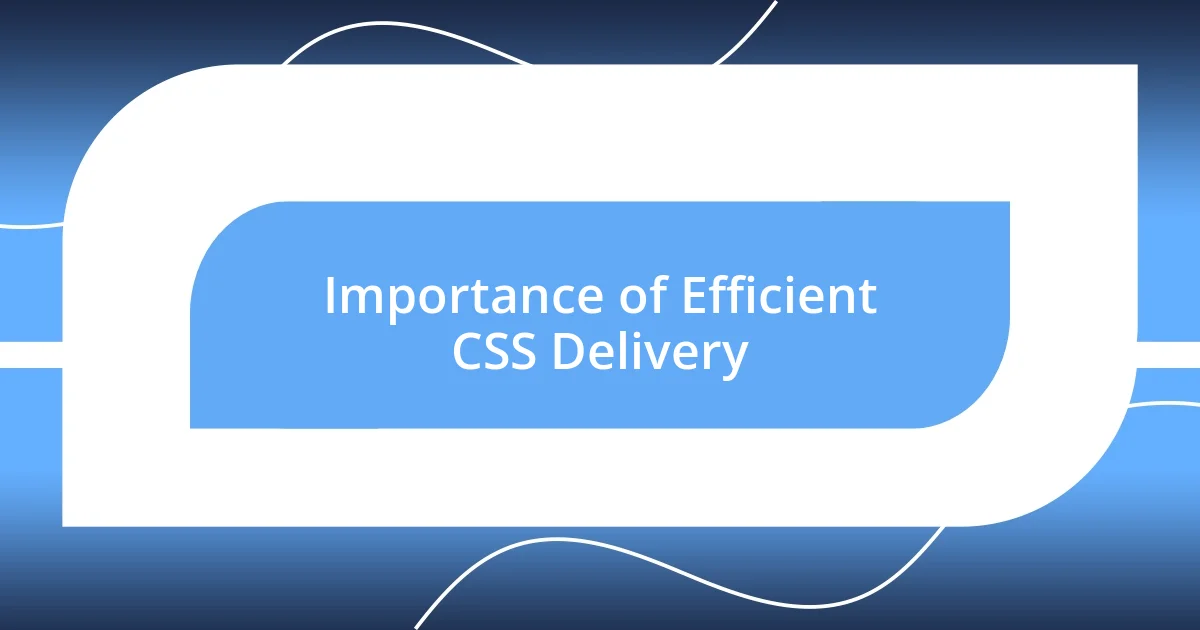Key takeaways:
- Understanding different CSS delivery methods—inline, embedded, and external—can significantly impact website performance and user experience.
- Implementing efficient CSS delivery leads to improved load times, better SEO, and reduced bounce rates, enhancing user satisfaction.
- Testing and measuring the impact of CSS delivery methods, utilizing tools like Chrome DevTools and Lighthouse, provides valuable insights into user engagement and overall site performance.

Understanding CSS Delivery Methods
When I first dived into CSS delivery methods, I was fascinated by how they affect website performance. The choice between inline styles, embedded styles, and external stylesheets can significantly impact loading times and user experience. I often wondered, how can a simple decision about CSS delivery transform a website’s overall efficiency?
There’s a certain thrill that comes with optimizing CSS delivery methods. For instance, I remember shifting to external stylesheets for a project and witnessing a noticeable improvement in page load speed. It was like flipping a switch; everything felt snappier, and I received immediate feedback from users. This simple change reinforced my belief that understanding the nuances of CSS delivery is essential for any developer who wants to enhance site performance.
It’s also crucial to consider how different methods can cater to various projects. Have you ever faced an issue with conflicting styles when using embedded CSS? I have, and let me tell you—it was a headache that could have easily been avoided by sticking to external stylesheets for that project. Each method has its place, and knowing when to use each can make all the difference in creating a seamless web experience.

Importance of Efficient CSS Delivery
Efficient CSS delivery is crucial because it directly influences a website’s loading speed and user satisfaction. I’ve seen firsthand how users react to delayed loading times; their patience wears thin quickly. It’s like watching a balloon slowly deflate—deflating the excitement they had for your site. When I optimized CSS delivery, I didn’t just see faster load speeds; I also felt the enthusiasm from my audience boost as their experience improved.
Here’s why efficient CSS delivery matters:
- Improved Load Times: Faster loading directly correlates with better user engagement.
- Enhanced User Experience: A snappier site feels more responsive and enjoyable to navigate.
- Better SEO Performance: Search engines reward quicker websites, giving you higher visibility.
- Reduced Bounce Rates: Users are less likely to leave if your site loads promptly.
- Consistent Styling: Utilizing effective CSS methods minimizes the risk of style conflicts, streamlining maintenance.
I know that improving these aspects can make a tangible difference in retaining visitors and turning them into loyal users. It’s an exhilarating journey, one that significantly transforms how users interact with our websites.

Analyzing Different CSS Techniques
When analyzing different CSS techniques, it’s fascinating to see how each method plays a specific role in delivering styles effectively. I once experimented with inline CSS for a small project, thinking it would make my work easier. However, I quickly found that while it provided immediate visibility, maintaining those styles became a nightmare. It was a real eye-opener, showing me that sometimes, the most straightforward solutions can complicate things down the line.
Embedded styles can be beneficial in certain scenarios, like quick prototypes or when you need to manage a small number of styles. I remember using embedded CSS for a landing page, which allowed for fast edits, but I quickly realized the long-term implications. As the project grew, the messy code left me searching through layers of styles, which could have easily been avoided with an organized external stylesheet. This experience taught me the importance of planning ahead when choosing a CSS delivery technique.
On the other hand, external stylesheets offer a level of organization that I can’t overlook. I recall a project where switching to external stylesheets not only improved load times but also made collaboration with another developer seamless. It felt refreshing to have all styles centralized, and navigating through our code felt like a breeze. Each technique has its pros and cons, yet aligning the chosen method with project goals is key to maximizing efficiency.
| CSS Technique | Pros | Cons |
|---|---|---|
| Inline CSS | Quick implementation, immediate style visibility | Hard to maintain, can lead to bloated HTML |
| Embedded CSS | Good for small projects, easy to edit | Messy code for larger projects, potential redundancy |
| External Stylesheets | Organized, improved load times, better collaboration | Requires separate file, slight overhead in initial loading |

Implementing Critical CSS Strategies
Implementing critical CSS strategies can be a game changer for website performance. I recall a specific project where I decided to extract critical CSS, focusing on styles needed for the above-the-fold content. It was a meticulous process, but I was astounded at the difference it made in load times. Watching the page render almost instantaneously brought a smile to my face, seeing how my efforts translated into a superior user experience.
One approach that I found incredibly effective was to use a tool to automate critical CSS extraction. Initially, I was skeptical—could a tool really capture everything necessary? However, when I experimented with a few different ones, I discovered that some tools did an admirable job. The first time I witnessed my website load quickly while maintaining a perfect layout, it was like a lightbulb moment. Don’t you just love those moments when things finally click?
Another strategy worth mentioning is utilizing media queries strategically for critical CSS. I learned this firsthand during a responsive design project. As I segmented styles based on device size, I noticed that not only did the site load faster on mobile, but the overall user experience became so much smoother. I’ve learned to appreciate the nuances of critical CSS; it’s not just about loading fast, but also about creating a seamless experience that resonates with users. Have you ever thought about how a fraction of a second can impact their perception of your whole site? It’s crucial to treat those minutes and seconds with the utmost care.

Utilizing Asynchronous CSS Loading
Utilizing asynchronous CSS loading has been a significant step in optimizing website performance for me. I remember a time when I relied solely on blocking stylesheets, which delayed page rendering and caused users to experience a frustrating wait. Switching to asynchronous methods allowed the browser to continue loading other elements on the page while fetching my stylesheets, leading to noticeably faster perceived load times. Have you ever felt a page come to life before your eyes? That’s the magic of asynchronous loading.
One technique I found particularly engaging was the <link rel="preload"> method. Initially, I was unsure if this would make a real difference. But when I tested it on a recent project, I was amazed at how it prioritized critical styles. This approach helped ensure that my most important styles were available as early as possible, without blocking the rest of the content. It felt like I’d finally discovered an extra gear in the engine of my website, and it’s exciting to witness such a swift impact on user experience!
I’ve also experimented with JavaScript to load CSS asynchronously. At first, it seemed overly complicated. However, as I delved into it, I realized how much control it gave me over the timing of my styles. By encapsulating my CSS loading in a small script, I could enhance page interactivity seamlessly. Have you ever tried this method? The satisfaction of fine-tuning how styles are applied felt like completing a masterpiece that my users could appreciate instantly. It’s a simple yet transformative experience that I’d recommend trying out!

Testing and Optimizing CSS Delivery
Testing the CSS delivery methods is where the real magic happens. I recall a time when I decided to stress-test my website after applying a new delivery technique. Watching the performance metrics shift dramatically was exhilarating; I was able to identify bottlenecks that I never noticed before. It felt like uncovering hidden treasures within my code, and I couldn’t help but grin at the results.
One powerful tool I’ve leaned on for this phase is Chrome DevTools. It’s almost like having a backstage pass to my website’s performance. I ran various audits, tweaking CSS files and observing how changes impacted load times. When I reduced the size of certain stylesheets, the impact was immediate; the metrics reflected a noticeable drop in loading times. It’s fascinating how these small optimizations led to a big leap in user satisfaction.
As I continued experimenting, I began implementing A/B testing to compare different CSS delivery strategies. Each test brought new insights that altered my approach. Does this method feel too complicated? Trust me, it’s worth it. I found joy in analyzing real user data—not just numbers, but real interactions. Each feedback loop guided my next steps, confirming or challenging my instincts. The process felt less like a chore and more like an intricate puzzle; every successful optimization brought a sense of achievement and a desire to learn even more.

Measuring Impact on Performance
Measuring the impact of my CSS delivery methods has been a vital part of my optimization journey. I remember my early days when I relied solely on metrics like Time to First Paint (TTFP) without much context. Once I started incorporating more comprehensive metrics such as First Contentful Paint (FCP) and Largest Contentful Paint (LCP), the insights were profound. Have you ever felt the thrill of seeing your changes reflected in real-time metrics? It’s almost like the data comes alive, showing you exactly how users are experiencing your site.
Another significant aspect is understanding user behavior through analytics. I often find myself diving into user paths after deploying a new CSS loading strategy. It’s enlightening to see how slight tweaks can enhance engagement, such as reducing the bounce rate by merely a few seconds of load time. There was a point in one of my projects where I identified a drop in interaction right after CSS changes. Analyzing those patterns guided me toward specific improvements, and it felt like being a detective solving a compelling case—each piece of data nudging me closer to the solution.
I also learned to embrace tools like Lighthouse for a broader perspective. After running my CSS optimizations, running Lighthouse audits felt akin to receiving a performance report card. The scores became not just numbers, but reflections of my efforts to enhance user experience. Still, I often ask myself, “Are these numbers enough, or do they truly reflect user sentiment?” Ultimately, I discovered that the combination of analytics and user feedback creates a complete picture—not just how fast the site loads, but how satisfied my users are. That revelation truly changed my approach!














